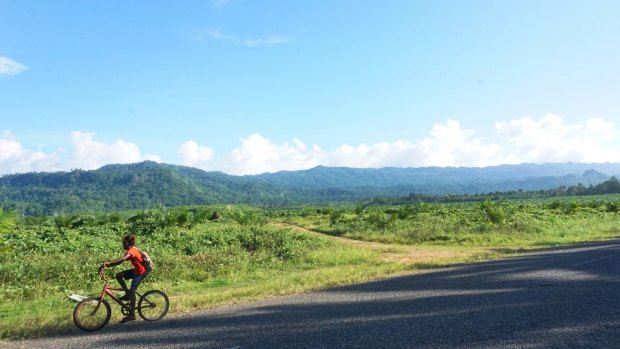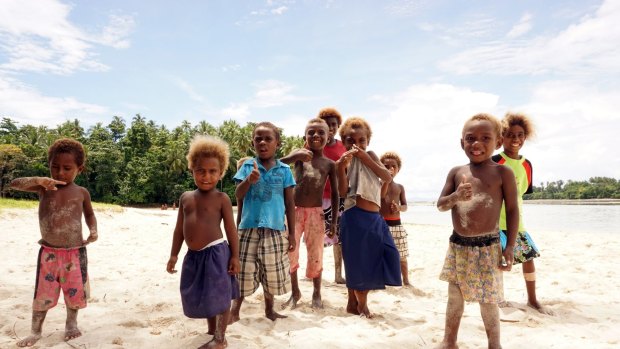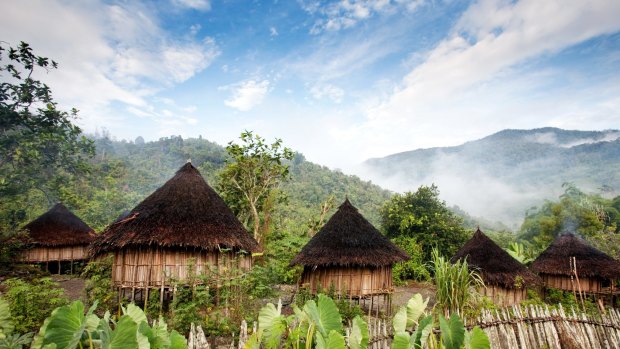This was published 9 years ago
Papua New Guinea cycling tour: This is not the Tour de France
A coastal bike trip on a Papua New Guinea island brings nature and culture close, writes Inga Ting.
By Inga Ting

Scenic route: Cycling in New Ireland.Credit: Inga Ting
It usually begins with one kid. His eyes widen. His face, his posture, his whole body, come alive as he musters every ounce of energy into a single intake of breath.
"Turis! (Tourist!)" he screams. His cry has the kind of urgency that kids where I grew up reserve for truly life-changing events, like sightings of the ice-cream man.
"Turis! Turis! Turis!"

Welcoming party: Local children are excited by the arrival of tourists.Credit: Inga Ting
And so begins the madness.
Heads pop out from door frames. Women cast aside half-washed laundry. School children abandon books. People start to run: toddlers chased by mothers, children balancing babies, men and women of all shapes and ages, with the sick and elderly bringing up the rear.
Men and women rush to pick flowers for you. Children queue to exchange high fives with you. Everyone is smiling and calling out, until the entire village is a cheerful chorus of "Moning! (Good morning!)", "Apinun! (Good afternoon!)" and "Halo! What's your name?"

Traditional thatched roof houses in Papua New Guinea.Credit: 123.com
It's like the Tour de France but at a fraction of the speed and much less skill.
It is the second day of our cycling expedition along New Ireland's Boluminski Highway. I am a smelly, ragged excuse for a tourist. Yet this does nothing to dampen their excitement and even though this circus happens at nearly every village (and there are dozens), I still feel like I should do something, well, amazing. Or at least slightly more interesting than cycling very slowly and sweatily through the crowd. I summon the energy to ring my bell and call back, smiling and waving as though I am moderately fit and not at all bothered by the blazing heat.
Cycling in New Ireland is ideal for those looking for a cheap, eco-friendly way to experience the charms of village life and the natural beauty of Papua New Guinea's islands. Surfaced for the first 200 kilometres with guesthouses scattered conveniently along the way, the highway is almost perfectly flat and surprisingly traffic-free.
Which makes it perfect for those who like getting outdoors but aren't hardcore cyclists, and certainly don't want to wear Lycra on holiday (or ever).
The journey from Kavieng to Dalom, roughly 180 kilometres, is our first attempt at a multiday cycling trip. We're running late, having spent half our first day hiding from the teeming rain in a bamboo shelter by the side of the road.
Conscious of needing to make up serious distance, I am trying to pick up the pace.
"Stop riding so far in front of me!" This distant protest comes from my partner, who less than 24 hours earlier had declared 90 kilometres was not too far to cycle each day. I am carrying all our luggage, food and water in the (apparently false) hope that the lighter Kris' load, the faster he'll ride.
When I am not trying to work out if I could jog faster than Kris is cycling, the ride is supremely peaceful. From the saddle of an 18-speed, I watch scenes of island life slip by: clusters of thatched-roof houses by the beach; men and children fishing from banana boats; sleepy shopkeepers manning roadside stalls offering two-minute noodles, cigarette lighters and greasy pink donuts. (Who says all your island needs can't be found in one place?) For long stretches, the only sign of civilisation is the odd buai (betel nut) stand: a dozen or so neatly arranged nuts on a plank of wood, no vendor in sight.
By 11 o'clock the vortex of tangled trees and vines around us goes still and gusts of hot air rise from the asphalt like the road itself is breathing. Time for a swim.
Rarely are we more than 200 metres from crystal clear water, gentle swells and white sandy beaches. We stop for lunch at a tiny village and immediately pick up a small entourage of women and children. As we lay out a towel under a coconut tree, we're approached by a round, shirtless man with curly grey hairs on his generous belly.
Johnson has come to see what all the fuss is about. He shakes our hands; we exchange names. There's an awkward pause as everyone falls silent. Somewhere, a tumbleweed rolls by.
Ah-ha! I realise what is going on. Johnson is the village bigman (leader) and we are visitors on their turf. We rummage around for a gift but all we come up with is tinpis (canned tuna) and a mangled packet of dry crackers. They make for a rather sad-looking gift.
But our embarrassment finds quick relief: Johnson nods his approval. "Please stay for lunch. The women will look after you." And with that, he breaks the three crackers in the packet into tiny pieces and distributes them between the dozen or so villagers standing around us.
Johnson is the first bigman we've ever met and our brief interaction, as absurd as it might seem, felt remarkably genuine. Generosity, exchange and kinship are the backbone of Melanesian culture and this unexpected roadside encounter is like a first glimpse into its soul.
New Ireland is one of the few places in the world where people still live much like they did 100 years ago, and their warmth and curiosity is impossible to resist. Instead of cycling, we find ourselves chatting to school teachers, bathing in the river with students, learning to weave baskets and staying up late listening, wide-eyed, to tales of witchcraft.
In the end, we do make it to Dalom – on the passenger seat of a truck with our bikes stashed in the tray. Better to slow down, kick up your feet and let the island tempo take you, than tear past it all at 40km/h just so you can say you made it in time.
After all, it's not the Tour de France.
TRIP NOTES
MORE INFORMATION
GETTING THERE
Kavieng is 1.5 hours from Port Moresby by air. Air Niugini operates daily flights. Phone +675 327 3396, see airniugini.com.pg
STAYING THERE
Locals will tell you it is possible to stay in any villager's house (just ask!) but staying at guesthouses allows you to phone ahead. Since most guesthouses generally host only a few guests each month, advance notice is much appreciated – and probably means you'll be better fed since your hosts will have time to go fishing/shopping/bush gathering. The only time New Ireland gets crowded is when students from Melbourne do their annual cycling trip (usually in July). At other times, you're likely to have the entire guesthouse to yourself.
Accommodation is basic. Most guesthouses rely on rainwater, cook on wood stoves and run a generator in the evening. The standard guesthouse price for two people is K240 ($A113) a night, including dinner and breakfast. Village stays are about K160 ($A75) a night, including dinner and breakfast.
New Ireland Tourist Bureau (+675 984 2441; +675 7271 7426; newirelandtourism.org.pg) can arrange bookings. Recommended guesthouses include Tabo Meli's Guesthouse at Lauan (about 48 kilometres from Kavieng; +675 7322 2645; no website) and Dalom Village Guesthouse (about 176 kilometres from Kavieng; +675 7220 4031; no website).
SEE + DO
The Boluminski Highway runs the island's east coast from the province capital Kavieng to Namatanai, roughly 260 kilometres away. How far you ride is up to you – you'll need four to five days to cover the entire stretch. Kavieng is the only place on the island where you can withdraw or exchange money, and the only place you'll find (relatively) large supermarkets, so stock up on water, lunch supplies and snacks for your entire trip before heading off. It's a good idea to take a few items to offer to either your hosts if you're at a village stay or to the village bigman for redistribution. Canned fish, rice, salt, sugar and other long-life condiments will win you friends.
You can hire an 18-speed mountain bike with a helmet and cushioned seat cover (for which you will be grateful by the end of your first day) for K60 ($A28) a day from John Knox, Noxie's Place (+675 7369 3331; facebook.com/NoxiesPlace). If you're planning to go one way, he'll pick up your bikes from anywhere along the highway for K40 ($A19) a bike, and drop off any luggage you don't want to take cycling at no extra charge.
Sign up for the Traveller Deals newsletter
Get exclusive travel deals delivered straight to your inbox. Sign up now.